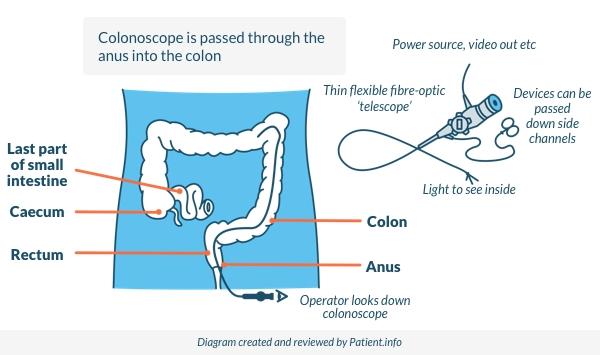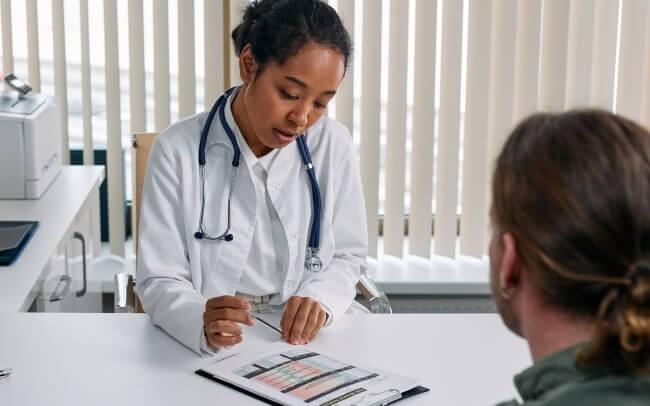Colonoscopy
Peer reviewed by Dr Colin Tidy, MRCGPLast updated by Dr Claudia Berty, MRCGPLast updated 30 Mar 2023
Meets Patient’s editorial guidelines
- DownloadDownload
- Share
- Language
- Discussion
In this series:Bowel cancerBowel cancer screeningFaecal immunochemical testSigmoidoscopyCT colonographyBowel polyps
A colonoscopy is a test to assess your colon (large intestine).
Note: the information below is a general guide only. The arrangements, and the way tests are performed, may vary between different hospitals. Always follow the instructions given by your doctor or local hospital.
In this article:
Continue reading below
What is a colonoscopy?
Colonoscopy new

A colonoscopy is a test where an operator - a doctor or nurse - looks into your colon using a colonoscope. The colon is sometimes called the large intestine or large bowel. The colon is the part of the gut which comes after the small intestine. The last part of the colon leads into the rectum where stools (faeces) are stored before being passed out from the back passage (anus).
A colonoscope is a thin, flexible telescope. It is about as thick as a little finger. It is passed through the anus and into the colon. It can be pushed all the way round the colon as far as the caecum (where the small and large intestine meet). Another test called sigmoidoscopy looks at the rectum and the lower part of the colon. See the separate leaflet called Sigmoidoscopy for more details.
The colonoscope contains fibre-optic channels which allow light to shine down so the operator can see inside your colon.
The colonoscope also has a side channel down which devices can pass. These can be manipulated by the operator. For example, the operator may take a small sample (biopsy) from the inside lining of the colon by using a thin 'grabbing' instrument which is passed down a side channel.
What is a colonoscopy for?
A colonoscopy may be advised if you have symptoms such as:
Bleeding from the back passage (anus).
Pains in the lower tummy (abdomen).
Persistent diarrhoea.
Other symptoms thought to be coming from the colon.
The sort of conditions which can be confirmed include:
Ulcerative colitis (which causes inflammation of the colon).
Crohn's disease (which also causes inflammation of the colon).
Pouches which form in the lining of the colon (diverticula).
Various other conditions may also be detected. Also, a colonoscopy is often normal. However, a normal result may help to rule out certain possible causes of your symptoms.
Continue reading below
What happens during a colonoscopy?
Colonoscopy is usually done as an outpatient or day case. It is a routine test which is commonly done. You will usually be given a sedative to help you to relax. This is usually given by an injection into a vein in the back of your hand. The sedative can make you drowsy but it does not put you to sleep. It is not a general anaesthetic.
You lie on your side on a couch. The operator will gently push the end of the colonoscope into your back passage (anus) and up into the colon. The operator can look down the colonoscope and inspect the lining of the colon. Also, modern colonoscopes transmit pictures through a camera attachment on to a TV monitor for the operator to look at.
Air is passed down a channel in the colonoscope into the colon to make the inside lining easier to see. This may cause you to feel as if you want to go to the toilet (although there will be no stools (faeces) to pass). The air may also make you feel bloated, cause some mild 'wind pains', and may cause you to pass wind. This is normal and there is no need to be embarrassed, as the operator will expect this to happen.
The operator may take small samples (biopsies) of some parts of the inside lining of the colon - depending on why the test is done. This is painless. The biopsy samples are sent to the laboratory for testing and to be looked at under the microscope. Also, it is possible to remove polyps, which may be found, with an instrument attached to a colonoscope. (Polyps are small lumps of tissue which hang from the inside lining of the colon.) At the end of the procedure the colonoscope is gently pulled out.
How long does a colonoscopy take?
A colonoscopy usually takes about 20-30 minutes. However, you should allow at least two hours for the whole appointment to prepare, give time for the sedative to work, for the colonoscopy itself and to recover.
Continue reading below
Is a colonoscopy painful?
A colonoscopy does not usually hurt but it can be a little uncomfortable, particularly when the colonoscope is first passed into the anus.
Virtual colonoscopy
A newer type of colonoscopy called a virtual colonoscopy is available. It is sometimes known as computerised tomography (CT) colonography or CT colonoscopy. It may be suggested as appropriate for you to have if:
You have had a conventional colonoscopy and your doctor was not able to visualise the entire large bowel.
There are technical reasons why it is difficult to do a colonoscopy.
This type of colonoscopy is performed using a CT scan to take an image of the bowel. A thin tube is put into the back passage to put air into the bowel to help produce clear images. The CT scan then produces images of the large bowel.
How to prepare for a colonoscopy
You should receive instructions from the hospital department before your test. The sort of instructions given include:
The colon needs to be empty so that the operator can obtain a clear view. You will be instructed on how to take a special diet for a few days before the test. You will also be given some laxatives to take.
You will need somebody to accompany you home, as you will be drowsy with the sedative.
What to expect after a colonoscopy
Most people are ready to go home after resting for half an hour or so. You may need to stay a bit longer for observation if you have had any small lumps of tissue (polyps) removed.
If you have had a sedative - you may take a bit longer to be ready to go home. The sedative will normally make you feel quite pleasant and relaxed. However, you should not drive, operate machinery, drink alcohol, take important decisions or sign documents for 24 hours after having the sedative. You will need somebody to accompany you home and to stay with you for 24 hours until the effects have fully worn off. Most people are able to resume normal activities after 24 hours.
The operator writes a report and sends it to the doctor who requested the colonoscopy. The result from any sample (biopsy) may take a few days, which can delay the report being sent.
The operator may also tell you what he/she saw before you leave. However, if you have had a sedative, you may not remember afterwards what you were told. Therefore, you may wish to have a relative or close friend with you who may be able to remember what was said.
Are there any side-effects or complications from having a colonoscopy?
Most colonoscopies are done without any problem. The sedative may cause you to feel tired or sleepy for several hours afterwards. You may pass a small amount of blood from your back passage (anus) if a biopsy was taken or if a small lump of tissue (polyp) was removed. You may also have leakage of liquid accompanied by gas for up to 24 hours after taking the last dose of laxatives. You should arrange your work/social activities following a colonoscopy with this in mind.
Occasionally, the colonoscope may cause damage to the colon. This may cause bleeding, infection and (rarely) a hole (perforation). If any of the following occur within 48 hours after a colonoscopy, consult a doctor immediately:
Tummy (abdominal) pain. (In particular if it becomes gradually worse and is different or more intense to any 'usual' pains that you may have.)
Raised temperature (fever).
Passing a lot of blood from your anus.
Patient picks for Endoscopy

Surgery and procedures
Gastroscopy
Gastroscopy is a test to look inside the gullet (oesophagus), the stomach and the first part of the gut (small intestine) known as the duodenum. Note: the information below is a general guide only. The arrangements, and the way tests are performed, may vary between different hospitals and areas. Always follow the instructions given by your doctor or local hospital.
by Dr Philippa Vincent, MRCGP

Surgery and procedures
Sigmoidoscopy
A sigmoidoscopy is a test that looks at the rectum and lower part of the large intestine. Note: the information below is a general guide only. The arrangements and the way tests are performed, may vary between different hospitals. Always follow the instructions given by your doctor or local hospital.
by Dr Claudia Berty, MRCGP
Further reading and references
- Colonoscopic surveillance for prevention of colorectal cancer in people with ulcerative colitis, Crohn's disease or adenomas; NICE Clinical Guideline (March 2011 - last updated September 2022)
- Koo S, Neilson LJ, Von Wagner C, et al; The NHS Bowel Cancer Screening Program: current perspectives on strategies for improvement. Risk Manag Healthc Policy. 2017 Dec 4;10:177-187. doi: 10.2147/RMHP.S109116. eCollection 2017.
- Meier B, Caca K, Fischer A, et al; Endoscopic management of colorectal adenomas. Ann Gastroenterol. 2017;30(6):592-597. doi: 10.20524/aog.2017.0193. Epub 2017 Sep 23.
Continue reading below
Article history
The information on this page is written and peer reviewed by qualified clinicians.
Next review due: 16 Feb 2028
30 Mar 2023 | Latest version

Ask, share, connect.
Browse discussions, ask questions, and share experiences across hundreds of health topics.

Feeling unwell?
Assess your symptoms online for free
Sign up to the Patient newsletter
Your weekly dose of clear, trustworthy health advice - written to help you feel informed, confident and in control.
By subscribing you accept our Privacy Policy. You can unsubscribe at any time. We never sell your data.